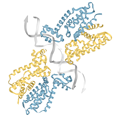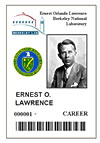


As the world's demand for energy increases, billions of dollars are dedicated to the search for deep-water hydrocarbon reservoirs each year. Although seismic imaging methods have long been used to collect valuable information on geological structures bearing hydrocarbon deposits, they have not proven effective in discriminating different types of reservoir fluids, such as brines, oil, and gas. Because of this inability to discriminate, over time huge financial losses result from drilling dry holes—up to $100 million dollars per each unsuccessful drilling. Meanwhile significant hydrocarbon reservoirs remain undiscovered. More>

 One of the pioneering contributions made by researchers in Berkeley Lab's Genomics Division is the demonstration that areas of the human genome that do not encode the functional units or genes, the so-called noncoding regions (previously referred to as "junk"), can actually exert a powerful regulatory influence on the expression of genetic traits, such as susceptibility to disease. Len Pennacchio and his Genomics Division colleagues have identified a strong link between a noncoding region of the human genome and susceptibility to cardiovascular or coronary artery disease (CAD), one of the major causes of mortality in the U.S. and the developed world. Pennacchio has been awarded an $842,908 Recovery Act grant by the National Heart, Lung and Blood Institute to develop a model to uncover the mechanism by which a certain noncoding region confers susceptibility to CAD. More>
One of the pioneering contributions made by researchers in Berkeley Lab's Genomics Division is the demonstration that areas of the human genome that do not encode the functional units or genes, the so-called noncoding regions (previously referred to as "junk"), can actually exert a powerful regulatory influence on the expression of genetic traits, such as susceptibility to disease. Len Pennacchio and his Genomics Division colleagues have identified a strong link between a noncoding region of the human genome and susceptibility to cardiovascular or coronary artery disease (CAD), one of the major causes of mortality in the U.S. and the developed world. Pennacchio has been awarded an $842,908 Recovery Act grant by the National Heart, Lung and Blood Institute to develop a model to uncover the mechanism by which a certain noncoding region confers susceptibility to CAD. More>
 World of Science: Quantum Entanglement Visible to the Naked Eye
World of Science: Quantum Entanglement Visible to the Naked Eye(Wired Science) By linking the electrical currents of two superconductors large enough to be seen with the naked eye, John Martinis and colleagues at UC Santa Barbara have extended the domain of observable quantum effects. Billions of flowing electrons in the superconductors can collectively exhibit a weird quantum property called entanglement, usually confined to the realm of tiny particles, scientists report in the Sept. 24 issue of Nature. More>
 Last Thursday, a SLAC/Stanford graduate student was exposed to a reflected laser beam during an alignment procedure. The student had temporarily removed required laser goggles and sustained a minor retinal burn. A "Stop Work" order was issued for all class 3B and 4 lasers at SLAC and is in effect until further notice. This is the first Department of Energy laser injury since early 2005. Contact Ken Barat for more information on the SLAC accident. Lab employees should remember that personal protective equipment (PPE) must be worn as required. This includes proper eyewear and clothing.
Last Thursday, a SLAC/Stanford graduate student was exposed to a reflected laser beam during an alignment procedure. The student had temporarily removed required laser goggles and sustained a minor retinal burn. A "Stop Work" order was issued for all class 3B and 4 lasers at SLAC and is in effect until further notice. This is the first Department of Energy laser injury since early 2005. Contact Ken Barat for more information on the SLAC accident. Lab employees should remember that personal protective equipment (PPE) must be worn as required. This includes proper eyewear and clothing.
 Site Access: Remember to Return Employee/Guest Badges
Site Access: Remember to Return Employee/Guest BadgesBerkeley Lab ID badges must be returned when an employee terminates employment or a guest appointment ends. Badges, parking permits, keys, and dosimetry badges must be surrendered during exit interviews. Guests must submit their badges and parking permits to their supervisor or host, divisional or HR contact, the Site Access Office (Bldg. 65A), or a badge return box, which are located near the Bldg. 65 bus stop, the ALS reception area, Bldg. 62/66, Molecular Foundry (Bldg. 67), NCEM (Bldg. 72), and the Bldg. 90 lobby. A new box has been installed in the lobby of the Guest House. Guests who have already left the Lab can mail their badges. Failure to return badges jeopardizes future access. Call Sam Houston (x4855) for more information.
 Health and Wellness: October is Breast Cancer Awareness Month
Health and Wellness: October is Breast Cancer Awareness MonthThe Lab’s Health Care Facilitator wants to remind employees that October is "Breast Cancer Awareness Month." Breast cancer remains the most frequently diagnosed cancer among women. It is second only to lung cancer in cancer deaths in the United States. Mammograms are the single most effective method to detect breast changes that may be cancer, long before physical symptoms can be seen or felt. For early-stage breast cancer, there are now more treatment options and survival rates have improved. Women over 40 should have a mammogram every year. More>
Today at Berkeley Lab is produced by Public Affairs' Communications Group